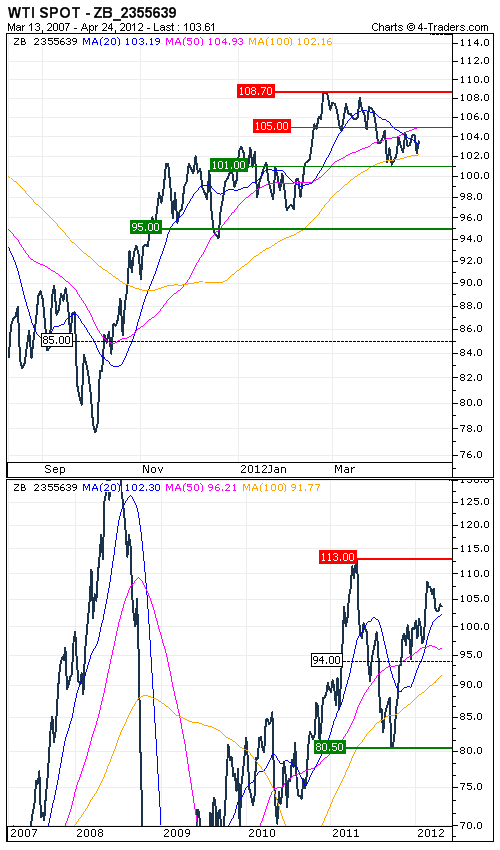WTI : No real trend
In an uncertain global economy, oil suffers from some profit taking. Indeed, some easing in prices has been observed in recent days following the publication of disappointing economic indicators especially in China. Meanwhile, the IEA (International Energy Agency) has disclosed in its monthly report, released in April, "a slight change in the trend of market fundamentals" in the first quarter. Higher global inventories and the production of OPEC members (31.43 million bpd in March, a level not seen since 2009) resulted in a decrease of $ 5 on average oil prices in international markets.
However, oil prices should remain close to $ 100 in a geopolitical context always nervous. On July 1st, all the countries of the European Union will do whithout Iranian production. In addition, new concerns persist about the conflict between Sudan and Southern Sudan where since March 26, the two armies are deployed in Heglig, a large oil area, which provides half of the production of Sudan and now claimed by Southern Sudan. On the April 16, the information minister of Southern Sudan has accused the Sudanese army to target the oil infrastructure in Heglig and asked the Security Council and the African Union to intervene. The consequences of this conflict on oil prices are not to be neglected mainly because of their respective supporters. Sudan is supported by Libya and the United States while Southern Sudan is held by Kenya, Israel and China.
Technically, the situation remains neutral in both daily data and weekly data. The waiting-game of investors facing the current situation has led the establishment of a long and narrow congestion between 95 and 115 dollars. We will wait for the breakout of this area to take upward or downward positions in order to benefit from any increase in volatility. An upward breakout could be violent in direction of the 150 dollars.

The content herein constitutes a general investment recommendation, prepared in accordance with provisions aimed at preventing market abuse by Surperformance, the publisher of MarketScreener.com. More specifically, this recommendation is based on factual elements and expresses a sincere, complete, and balanced opinion. It relies on internal or external data, considered reliable as of the date of their release. Nevertheless, this information, and the resulting recommendation, may contain inaccuracies, errors, or omissions, for which Surperformance cannot be held responsible. This recommendation, which in no way constitutes investment advice, may not be suitable for all investor profiles. The reader acknowledges and accepts that any investment in a financial instrument involves risks, for which they assume full responsibility, without recourse against Surperformance. Surperformance commits to disclosing any conflict of interest that may affect the objectivity of its recommendations.








